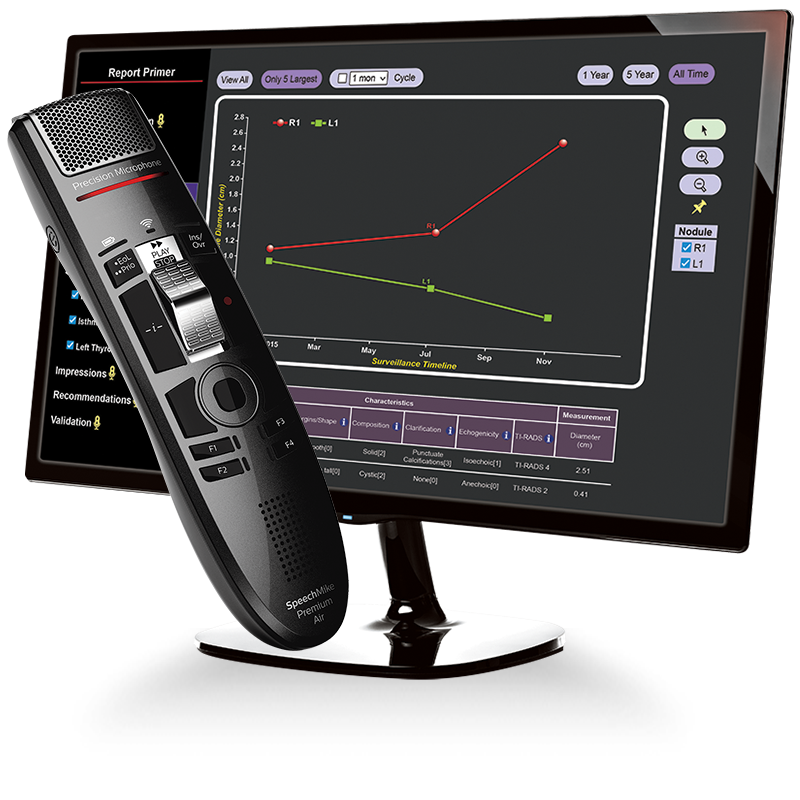Ultrasound Structured Reporting Software
9i Voice Activated, Hands-Free Digital Structured Reporting
…Old English Proverb
“Fast is Good, Faster is Better, Fastest is Best”…Old Radiology Proverb
CLICKVIEW 9i: Hands Free Reporting
All contemporary computer-based reporting systems such as structured templates and speech recognition systems rely on the computer mouse and keyboard to navigate and scroll the display screen for the entry of text and data. This creates significant distractions from the radiologist’s focus in trying to describe and diagnose the image findings on the screen. The mouse and keyboard slow report generation and are an annoying interruption of the radiologist’s workflow.
CLICKVIEW 9i innovative Voice Activation user interface uses of speech recognition to eliminate the need for the mouse and keyboard as text and data input devices for most reports. The user simply dictates the report in natural language and the system Smart Engine automatically places the text into the appropriate anatomical section of the report. Context sensitive Macros are inserted into the report with simple voice commands. User experience is enhanced by increased efficiency, faster report generation and a more intuitive workflow.
CLICKVIEW Corporation pioneered the development and application of Structured Reporting in the late 70s and early 1980s. There was an urgent need to report new data dense Gray Scale Obstetrical (OB) Ultrasound reports more clearly than was possible with standard text only reports. Simultaneously there was an urgent need to reduce the high costs of medical transcription in generating the reports. The solution was to use the emerging personal computer technology as a platform to create multimedia graphical reports.
To better understand the development of Ultrasound Reporting Software in Radiology it is helpful to briefly review how the need for structured reporting developed in Radiology and specifically for OB Ultrasound.
Figures 1 and 2 are the same OB Ultrasound report, Figure 1 is a conventional dictated all text report and Figure 2 a multimedia graphical report utilizing a trend chart (similar to Professor Campbell’s original publications) displaying a fetal growth curve and tables graphically organizing relevant biometric data and calculations for Estimated Gestational Age (GA) and Fetal Weight (FW) along with other findings.
Which is easier and faster to understand the exam findings?

Stuart Campbell DSc FRCPEd FRCOG FACOG, considered the father of obstetrical ultrasound, published the earliest papers on fetal biometry using bistable scan devices which displayed images on black and white video displays without gray shading. Professor Campbell published articles demonstrating BPD for the first time (1968); BPD growth chart (1969); IUGR BPD fetal growth chart (1971); and the first AC chart in 1975. Dr. Campbell’s obstetrical ultrasound reports consisted of one or both measurements as the basis for Gestational Age (GA) and Abdominal Circumference (AC) growth charts. Early OB reports, using only BPD
Gray scale imaging ultrasound scanners were first widely commercially available in the US in the mid-70s and produced high quality grayscale images which for the first time accurately visualized fetal soft tissues and enabled the development of additional fetal biometry. The improved accuracy of gray scale images of fetal biometry was the basis for the use of statistical analysis of the basic fetal biometric measurement data for determination of Gestational Age (GA), Fetal Weight (FW), Estimated Delivery Date (EDD) and others. Real time ultrasound scanners added to the profusion of data and calculations seeking to quantitate normal and abnormal fetal growth with new anatomical, cardiac, vascular, and doppler parameters.
In parallel to the evolution of OB ultrasound, the personal computer industry was in its infancy. With the release of MSDOS in 1980, the IBM PC in 1981 and PC specific programming languages, program development became accessible and affordable to anyone with an interest or a need. Earlier pre-DOS versions of the original CLICKVIEW program were ported to the MSDOS platform and development of the program accelerated. Within the next two years the earliest CLICKVIEW ultrasound structured reports incorporating fetal growth charts and tables were being sent to referral physicians on a routine basis. Report generation time was reduced to minutes and transcription costs reduced by about 90%.
The surge of fetal biometric data expanded the need to communicate OB data dense reports more efficiently than conventional text reports. Extensive multi-media displays of the fetal data were expanded to trend charts, tables, illustrations, images, cine clips, and a large array of reporting macros to describe the wide spectrum of findings displayed by the grey scale and real time technology.
In a short time, however, the burden of graphic display exceeded the capability of the contemporary PCs to process reports efficiently and stifled any interest of general radiologists, other than those in Ultrasound, to adopt structured reporting more widely. In addition, the deep cultural inertia of dictation as the conventional way for report generation contributed to the resistance to use a mouse and keyboard instead of dictation into a speech recognition system.
Nonetheless, concepts of data display developed for obstetrical reports and the power of advanced multimedia programming languages easily migrated to general ultrasound reports of the abdomen, doppler studies of the vascular system, thyroid nodules, tumor tracking, and other reports.
There is a reason we are referred to as
“The radiology structured reporting company”
35+
Years Structured Reporting Experience
25
Million Reports
20+
Years Web Architecture
~2.5
~1,500
Active Weekly Users

